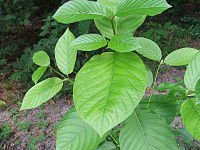
Photo from wikipedia
Abstract Mitragyna speciosa, known as kratom, is a tropical tree native to Southeast Asia that has long been used to increase energy and in traditional medicine. Kratom leaves contain several… Click to show full abstract
Abstract Mitragyna speciosa, known as kratom, is a tropical tree native to Southeast Asia that has long been used to increase energy and in traditional medicine. Kratom leaves contain several indole alkaloids including mitragynine, mitraciliatine, speciogynine, and speciociliatine, which have the same molecular formula and connectivity, but different spatial arrangements (i.e., diastereomers). A routine liquid‐chromatographic–high‐resolution mass‐spectrometric (LC‐HRMS) multi‐analyte method for addictive and herbal drugs in urine did not separate mitragynine from speciogynine and speciociliatine. Separation and individual measurement of the four diastereomers was possible with an improved LC method. All diastereomers were detected in 29 patient urine samples who tested positive for mitragynine with the routine method, albeit at variable absolute amounts and relative proportions. The presence of all diastereomers rather than individual substances indicated that they originated from the intake of kratom (i.e., plant material). Speciociliatine dominated in most samples (66%), whereas mitragynine and mitraciliatine were the highest in 17% each. A kratom product (powdered plant material) marketed in Sweden contained all diastereomers with mitragynine showing the highest level. In Sweden, there are signs of an increasing use of kratom in society, based on the results from drug testing, the number of poisons center consultations on intoxications, and customs seizure statistics. Because there may be health risks associated with kratom use, including dependence, serious adverse reactions, and death, analytical methods should be able to identify and quantify all diastereomers. In Sweden, this is important from a legal perspective, as only mitragynine is classified, whereas the other three diastereomers, and kratom (plant material), are not.
Journal Title: Drug Testing and Analysis
Year Published: 2022
Link to full text (if available)
Share on Social Media: Sign Up to like & get
recommendations!